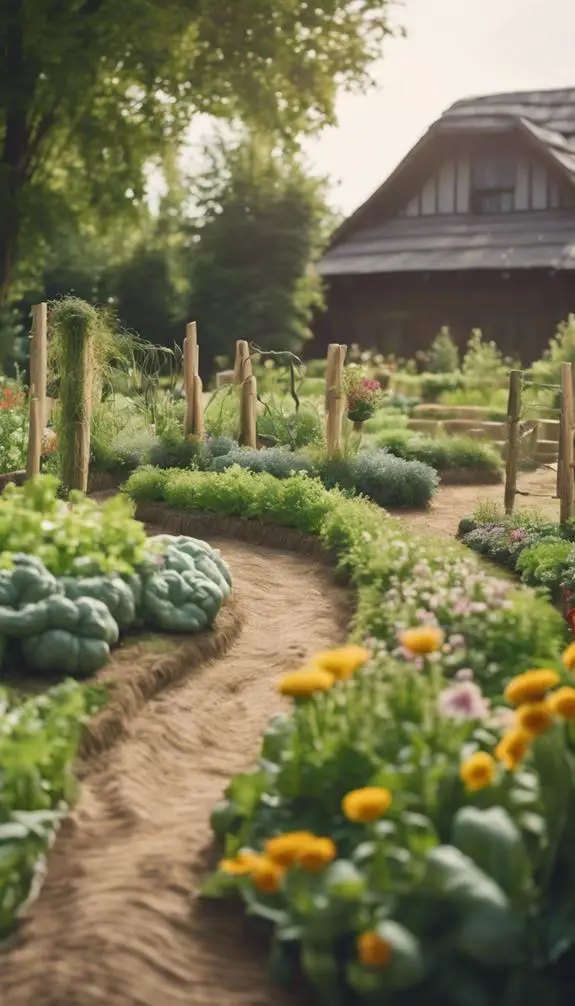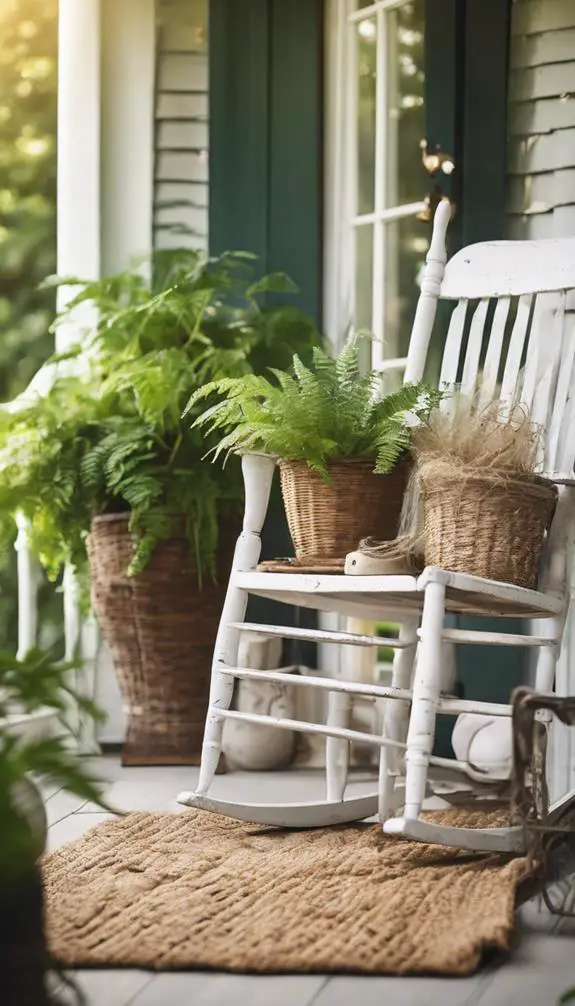As you stand in front of your fence, you can't help but envision a stunning border that adds curb appeal and transforms your outdoor space. You're not alone – many homeowners struggle to choose the right plants to create a beautiful and functional fence line. The good news is that with a little planning, you can create a breathtaking border that's both aesthetically pleasing and practical. From vibrant flowers to low-maintenance succulents, thorny intruder deterrents to fragrant blooms, the possibilities are endless. So, what's the secret to creating a stunning fence line that checks all the boxes?
Summary
- Select a mix of colorful perennials with different bloom times to create a stunning display of fence-side blooms that guarantee year-round interest.
- Incorporate drought-tolerant flowers, shrubs, and vines to create a low-maintenance fence line that thrives in various conditions.
- Choose a combination of deciduous and evergreen shrubs to add structure, texture, and varying levels of foliage throughout the seasons.
- Consider planting vines and climbing plants like English ivy, clematis, or roses to conceal an unsightly fence or create a sense of seclusion.
- Select native plants, succulents, and evergreen varieties to create a wildlife-friendly, low-maintenance, and visually appealing fence line.
Flowers for a Colorful Fence Line
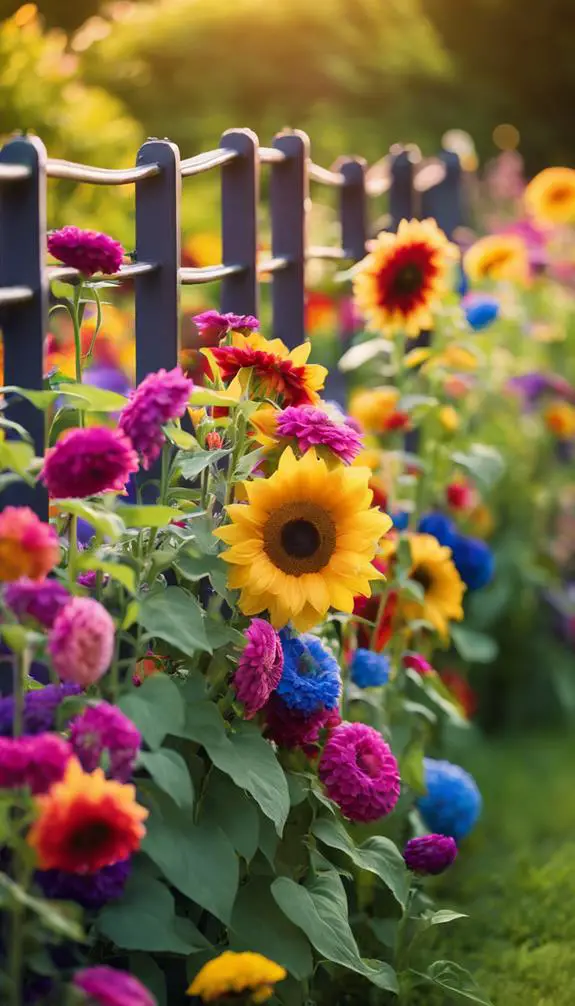
Several dozen vibrant flowers can transform a drab fence line into a picturesque boundary that adds curb appeal to your property.
By selecting a mix of colorful perennials, you can create a stunning display of fence side blooms that will brighten up your outdoor space. Consider planting a variety of flowers with different bloom times to guarantee year-round interest.
For a low-maintenance option, choose drought-tolerant flowers like coneflowers, black-eyed Susans, or salvias. These flowers are easy to care for and will thrive in a variety of conditions.
Shrubs for Year-Round Interest

While flowers can add a pop of color, shrubs provide a more permanent solution for year-round interest along your fence line.
They offer structure, texture, and varying levels of foliage throughout the seasons. Winter shrubs like winterberry and yew maintain their appeal even in the coldest months, with berries and evergreen foliage.
Early blooming shrubs like forsythia and quince signal the start of spring with vibrant flowers.
Consider incorporating a mix of deciduous and evergreen shrubs to create a dynamic display of color and texture.
Vines to Cover the Fence Fast

Frequently, homeowners seeking to conceal an unsightly fence or create a sense of seclusion turn to vines as a quick and effective solution.
You'll want to choose fast growers that can rapidly cover your fence. Look for fence climbers like English ivy, Boston ivy, or Virginia creeper, which can grow up to 8 feet per year. These vines have adhesive roots that allow them to cling to surfaces, making them ideal for covering chain-link or wooden fences.
For a more decorative option, consider flowering vines like clematis, wisteria, or trumpet vine. They'll add a pop of color to your fence line while still providing coverage. Just be sure to provide support and prune regularly to keep your vines healthy and under control.
Succulents for Low-Maintenance Beauty
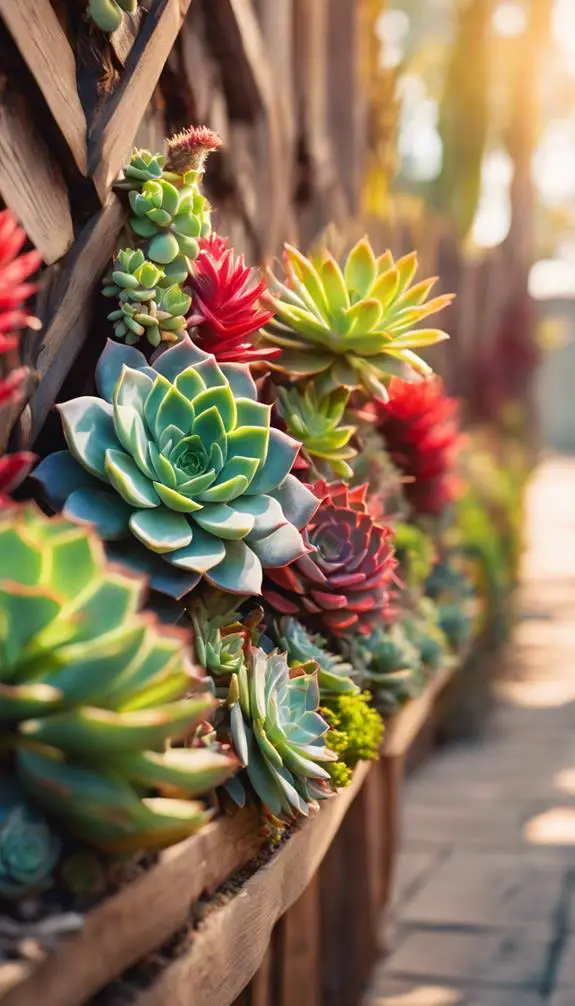
You'll appreciate the benefits of succulents along your fence line, where they'll thrive in dry conditions and require minimal upkeep, creating a drought-tolerant fence line that's both beautiful and resilient.
With versatile succulent varieties like aloe, agave, and echeveria, you can choose from a range of shapes, sizes, and colors to add visual interest to your fence.
Drought-Tolerant Fence Line
A rustic wooden fence, weathered to a silvery gray, provides the perfect backdrop for a vibrant display of drought-tolerant succulents.
You can create a stunning fence line by incorporating succulents that thrive in dry conditions. When designing your desert garden, consider fence post landscaping that incorporates succulents with varying textures, shapes, and sizes.
Plant them in a staggered pattern to create visual interest and depth. Use a mix of upright and trailing succulents to add dimension to your fence line.
As you plan your drought-tolerant fence line, remember to choose succulents that require minimal watering and maintenance. This will guarantee your fence line remains beautiful and thriving, even in hot and dry conditions.
Versatile Succulent Varieties
Three versatile succulent varieties stand out for their low-maintenance beauty: Echeveria, Sedum, and Crassula.
You can showcase these succulents in unique arrangements, combining them in creative ways to add visual interest to your fence line.
Consider using Succulent containers with good drainage to prevent waterlogged soil.
Echeveria's rosettes will add a pop of color, while Sedum's trailing stems will spill over the container's edges.
Crassula's small, rounded leaves will provide a delicate contrast.
By mixing and matching these varieties, you'll create a stunning, low-fuss border that thrives in hot, dry spots.
With minimal watering and care, your Succulent arrangements will flourish, bringing a touch of modern elegance to your outdoor space.
Herbs to Add Fresh Flavor

You can add a variety of herbs along your fence to elevate your cooking with fresh flavors.
Planting fresh mint will give you a constant supply for invigorating teas and desserts.
Basil, thyme, and other herbs will also thrive in this spot, allowing you to harvest them easily for Italian dishes, soups, and more.
Fresh Mint for Tea
Behind a fence, fresh mint thrives, providing an abundance of leaves perfect for steeping into a revitalizing tea.
As you plant mint varieties like peppermint, spearmint, or chocolate mint, consider the flavor profiles you want to achieve in your tea recipes.
For an invigorating twist, combine peppermint with lemon balm and honey for a soothing brew. Alternatively, pair spearmint with ginger and citrus for a zesty, energizing tea.
You can also experiment with different steeping times and temperatures to bring out the ideal flavor and aroma from your mint leaves.
Basil for Italian Dishes
Plant basil along your fence to add a burst of fresh flavor to your Italian dishes.
With over 160 basil varieties to choose from, you can select the perfect one to complement your favorite Italian recipes. Sweet basil, Genovese, and Thai basil are popular options that thrive in well-drained soil and full sun.
As you stroll along your fence, the fragrance of basil will fill the air, enticing you to harvest its leaves for a homemade pesto or caprese salad. Imagine the vibrant green leaves adding a pop of color to your fence border, while their sweet aroma wafts through the air, inspiring your next Italian culinary creation.
Thyme for Soups
Thyme's delicate, piney flavor is a staple in many soups, stews, and sauces, and growing it along your fence guarantees a fresh supply whenever you need it.
With a rich history dating back to ancient Greece, thyme has been prized for its culinary and medicinal benefits. You'll reap the rewards of thyme's antioxidants, antibacterial properties, and anti-inflammatory compounds in every dish.
Planting thyme along your fence provides easy access to its fragrant leaves, which pair perfectly with vegetables, meats, and legumes. As a low-maintenance, drought-tolerant herb, thyme thrives in well-draining soil and partial shade, making it an ideal choice for your fence border.
Harvest thyme leaves regularly to encourage bushy growth and enjoy the flavors of the Mediterranean in your own backyard.
Climbing Roses for Romance

As you envision a picturesque fence, climbing roses unquestionably come to mind, their delicate blooms and lush foliage conjuring up romantic fantasies.
To create this ambiance, choose varieties with fragrant, soft-petaled flowers in pastel hues. Ramblers like 'New Dawn' or 'Cécile Brunner' produce an abundance of small, delicate blooms that cascade down the fence, creating a sense of whimsy.
For a more structured look, try hybrid tea or floribunda varieties like 'Iceberg' or 'Zephirine Droughin'. Their larger, more vibrant blooms will create a dramatic, romantic ambiance.
As you walk along the fence, the soft rustle of rose petals beneath your feet will only add to the allure.
Ornamental Grasses for Movement

Beyond the romantic ambiance of climbing roses, you can inject a sense of dynamism into your fence line with ornamental grasses that sway gently in the breeze.
These grasses add a mesmerizing element to your border, creating a sense of movement that captivates the eye. With their feathery plumes and slender blades, ornamental grasses bring a light, airy texture to your fence line.
You can choose varieties with whimsical accents, like the golden tips of 'Karl Foerster' or the purple hues of 'Rubrum'.
The grassy textures and subtle color shifts create a dynamic visual interest that will keep your border looking fresh and engaging.
Evergreen Plants for Winter Interest

While ornamental grasses bring movement and life to your fence line, evergreen plants provide a steadfast presence throughout the year, especially during the winter months when other plants have gone dormant.
You can choose from a variety of evergreen varieties that offer winter interest, such as holly, arborvitae, and boxwood. These plants maintain their foliage year-round, providing a lush, green backdrop for your fence even in the dead of winter.
Consider planting them in a staggered pattern to create a visually appealing border. You can also prune them to maintain a desired shape or size, adding an extra layer of interest to your fence line.
Native Plants to Attract Wildlife

You can draw wildlife to your fence line by incorporating native plants that provide essential food, shelter, and habitat for local species.
By choosing plants that are indigenous to your region, you'll create a haven for wildlife to thrive. This approach supports habitat restoration and establishes wildlife corridors, allowing species to migrate and interact freely.
Native plants like coneflowers, black-eyed susans, and native grasses offer nectar, seeds, and shelter for various species. They also require less maintenance and care, making them an ideal choice for a low-fuss fence line.
Thorny Plants for Intruder Deterrent

By incorporating thorny plants into your fence line, you create a physical barrier that deters intruders, whether they're unwanted humans or curious wildlife.
These prickly barriers are an effective form of defensive landscaping, making it difficult for unwanted visitors to climb over or push through. Plants like barberry, pyracantha, and blackthorn are ideal for this purpose, with their dense, thorny foliage providing a robust obstacle.
When planted closely together, these species form an impenetrable hedge that's both visually striking and highly secure. By choosing the right thorny plants for your fence line, you can create a beautiful yet formidable barrier that protects your property and adds a touch of elegance to your outdoor space.
Fragrant Flowers for a Pleasant Scent
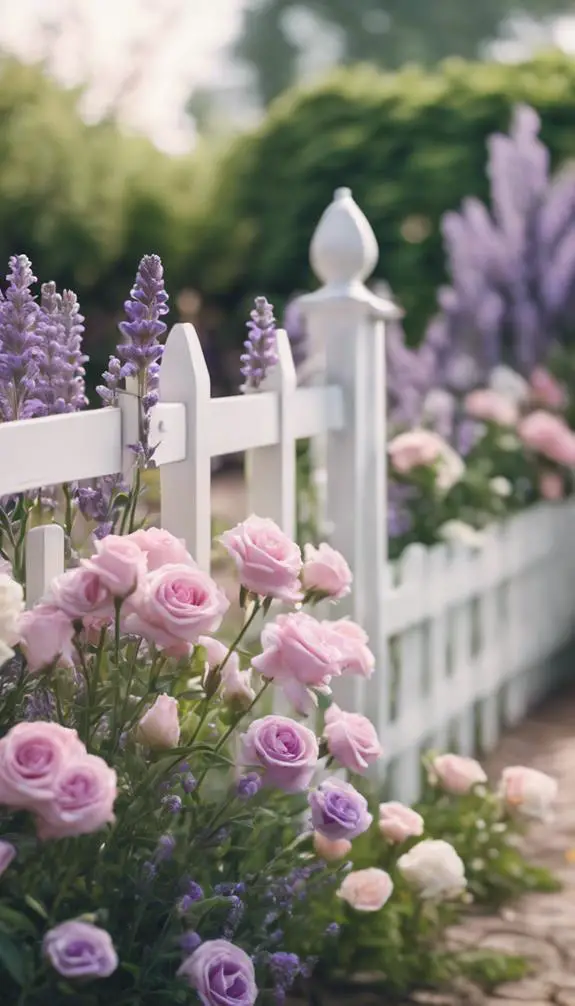
Planting fragrant flowers along your fence line can elevate the ambiance of your outdoor space, making it a more inviting and enjoyable area to relax or entertain.
You can create scented pathways that meander along the fence, enticing visitors to explore your garden. Fragrant borders, featuring flowers like lavender, roses, and freesia, can fill the air with sweet aromas, making your outdoor space feel like a serene oasis.
Consider planting flowers with different bloom times to guarantee a constant fragrance throughout the growing season. By incorporating fragrant flowers into your fence line design, you'll create a multisensory experience that will leave a lasting impression on anyone who visits your outdoor space.
Plants to Block Noise and Wind
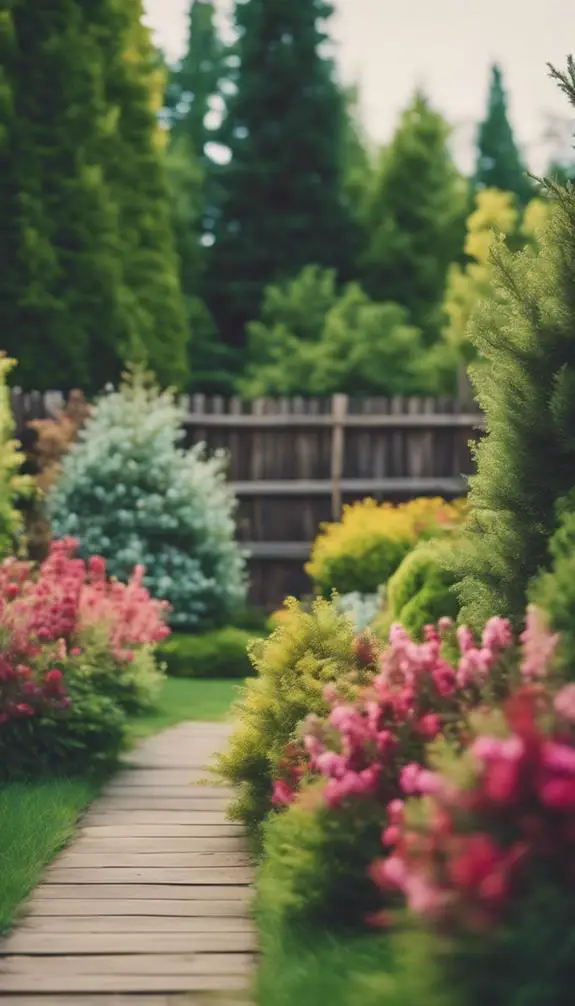
Noise and wind can quickly disrupt the serenity of your outdoor space, making it unpleasant to spend time in.
To combat this, you'll want to incorporate plants that serve as effective sound barriers and windbreaks. Dense, evergreen shrubs like Arborvitae and Leyland Cypress are ideal for blocking noise and wind.
You can also plant trees with broad canopies, such as Silver Maple or London Planetree, to deflect wind and reduce noise pollution. Additionally, consider incorporating plants with broad leaves, like Bamboo or Pampas Grass, which can help to dissipate wind energy.
Edibles to Grow Along the Fence
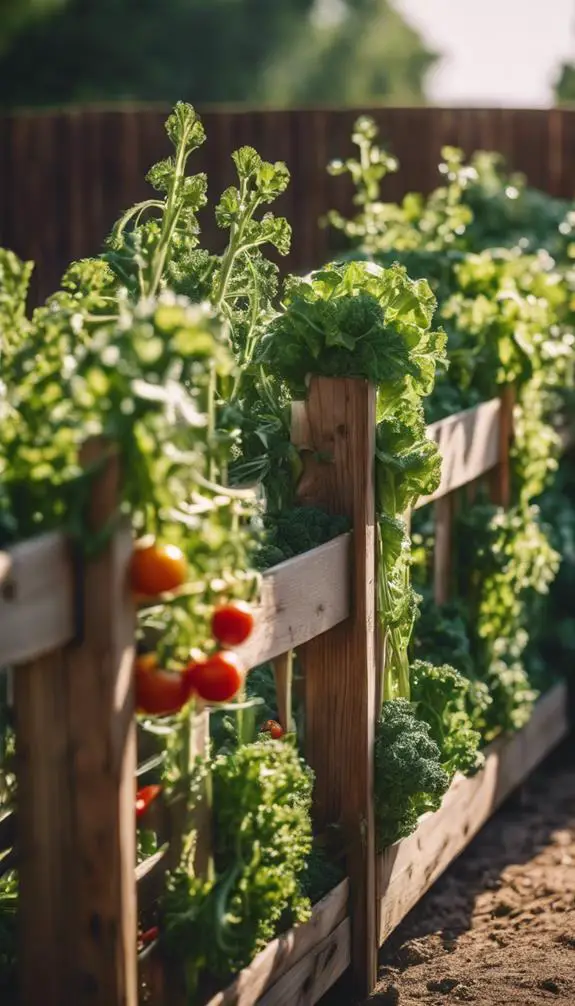
Transform your fence into a productive haven by incorporating edibles that thrive in narrow spaces.
You can train fruit trees like dwarf citrus, apple, or pear to grow vertically along your fence, providing shade and a bountiful harvest.
Berry bushes like blueberries, raspberries, or blackberries are another excellent option, requiring minimal space and maintenance. Train them to grow horizontally along the fence, creating a lush and fruitful border.
When selecting edibles, consider the fence's orientation, soil quality, and sunlight exposure to guarantee ideal growth. By doing so, you'll create a stunning and functional border that not only adds beauty to your outdoor space but also provides fresh produce right at your fingertips.
FAQs
Can You Plant Along a Fence With Partial Shade?
You can plant along a fence with partial shade by choosing shade-tolerant species that thrive in low-light conditions, carefully selecting varieties that won't outgrow your fence lines, and incorporating visual interest with textured foliage and blooms.
How Close to the Fence Should I Plant Flowers?
When planting flowers, you'll want to maintain a fence proximity of at least 6-8 inches to guarantee proper air circulation and sunlight penetration. Optimize flower spacing by staggering plants 12-18 inches apart, allowing for a lush, visually appealing display.
Do I Need to Prepare the Soil Before Planting?
Before planting, you'll want to test the soil to determine its pH level and nutrient content, then add amendments needed to create an ideal growing environment, ensuring your flowers thrive and your stunning border vision comes to life.
Will Deer Eat the Plants I Put Along My Fence?
You'll want to choose deer-resistant plants to guarantee fence protection, as whitetail deer can devour plants in no time; opt for species with unappealing tastes or textures, like lavender or boxwood, to safeguard your beautiful border.
Can I Use a Fence With Metal Posts for Planting?
You can use a fence with metal posts for planting, but consider the potential for metal rust and compromised post stability, which may affect the structural integrity of your fence and the health of your plants.
Conclusion
You've now got a wealth of options to create a stunning border along your fence. By mixing and matching flowers, shrubs, vines, succulents, herbs, thorny plants, fragrant flowers, and edibles, you can craft a unique look that suits your style and meets your needs. With these plants, you'll add curb appeal, structure, and texture to your outdoor space while also enjoying functional benefits like fragrance, flavor, and protection.


